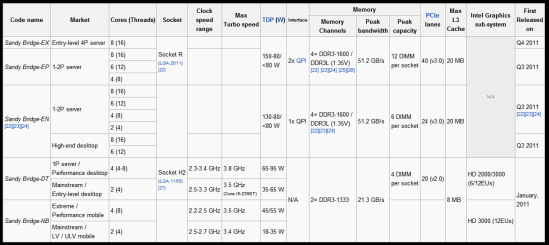Sandy Bridge is the codename for the processor micro-architecture developed by Intel as the successor to Nehalem. Development began in 2005 and was entirely developed in Intel’s research center located at Haifa – Israel. Sandy Bridge uses the same 32mn manufacturing process as Westmere.
It was set to be announced on January 5, 2011(may be today :P) during Consumer Electronics Show (CES) 2011, after which the first batch of mainstream processors will be launched.
Architecture:
Details of Sandy Bridge became available prior to launch. The specifications were reported to be as follows:
• Processing cores might feature Hyper-threading and/or Turbo Boost Technology depending on market segment, as with current Core i-series Nehalem-West mere processor generation.
• Standard CPU clock speed rated at 2.2 GHz to 3.4 GHz for variants with Turbo Boost Technology enabled, up to 3.8 GHz clock speed can be achieved.
• Integrated graphics core running at 650 MHz to 850 MHz with Turbo Boost Technology enabled, it can achieve up to 1350 MHz clock speed.
• Processors will feature different amounts of L3 cache on models in order to differentiate products among different market segments.
• 64 KB L1 cache/core (32 KB L1 Data + 32 KB L1 Instruction, 3 clocks) and 256 KB L2 cache/core (8 clocks).
• Up to 8 MB shared L3 cache (25 clocks) on a ring bus to be shared with the integrated graphics core.
• 256 bit/cycle Ring bus bandwidth. The ring bus connects the cores.
• All processors will feature a 64-byte cache line width.
• Decoded micro-op cache and enlarged, optimized branch predictor.
• Improved performance for transcendental mathematics, AES encryption, and SHA-1 hashing.
• Thermal design power (TDP) of products is rated at 35-95 W for desktop variants, and 18-55 W for mobile variants.
• Dual-core and quad-core processors will be available at launch, with six-core and eight-core processors planned for future release.
• X86 peak performances (with and without AVX): 30.4 DP GFLOPS / 7.6 DP GFLOPS per core (8 DP FP / 2 DP FP Per clock) @ 3.8GHz.
• Improved memory controller with maximum of 25.6 GB/s bandwidth supports DDR3-1600 dual channel RAM and two load/store operations per cycle.
• Pre-launch speculation anticipates:
o Sandy Bridge will be released for the mobile segment, and marketed into two CPU lines.
o Performance increase without a core transistor increase. Each CPU core is estimated at 20 mm², and dual-graphics core at 46 mm².
o Dynamic Turbo (Turbo 2.0) will allow the CPU power to exceed the TDP value when the rest of the platform is relatively cool. The frequency gain is expected to be up to 37 % for one minute and over 20 % in most cases.
Overclocking:
Overclocking of Socket-1155 compatible processors through modifying the default 100 MHz base clock speed is very limited, probably to about only 2–3% at most, due to the factory integrating a single clock generator to control the speed of all electrical buses. Hence, the base clock (BCLK) of the clock generator has to be kept close to the default 100 MHz base clock to prevent other hardware components from failing to work. However, Intel will allow overclocking through modifying the unlocked clock multiplier of up to 57 times the speed of base clock, which will be available in K-edition processors.
As reported on September 15, 2010: An Overclocking of the Sandy Bridge architecture appeared in an article by ZDNet. Their Core i7-2600K processor sample (where the “K” indicates the processor has an unlocked multiplier, allowing for overclocking) was able to operate at 4.9 GHz using an air-cooled solution. This has gained some attention due to the fact that achieving 4.9 GHz typically requires water or better cooling. Liquid Nitrogen Overclocking has refuted that it probably was not an accurate performance demo, saying “not a demo where the system was stressing all cores and threads, and it was not a statement confirming this could be maintained for 24×7 operation.” Liquid Nitrogen Overclocking has shown instances of a Core i7-2600K processor operating at 4.5 GHz on a Gigabyte P67A-UD7 (no graphics) motherboard, and a Core i5-2500K processor operating at 4.2 GHz using a Gigabyte H67MA-UDH2 motherboard. All other details are still unknown.
Intel Sandy Bridge E Processors are to come with an unlocked base clock. There are also rumours about a Z68 Chipset that came with what was referred to as “Performance Overclocking” support.
Other Details:
• Intel has stated that Sandy Bridge processors will include a new set of instructions known as Advanced Vector Extensions (AVX). These instructions are an advanced form of SSE.
• The data path is widened from 128 bits to 256 bits, the two-operand instruction limit is increased to three operands, and advanced data rearrangement functions are included.
• AVX is suited for floating-point-intensive applications. New features include mask loads, data permutes, increased register efficiency and use of parallel loads, as well as smaller code size.
• When AVX instruction is used in conjunction with these improvements, it provides double peak FLOPS performance compared to using SSE4 instructions on CPUs. Sandy Bridge will also have a new extensible VEX opcode prefix.
• In addition, Sandy Bridge processors will implement security features that include the ability to remotely disable a PC or erase information from hard drives.
• This can be useful in the case of a lost or stolen PC. The commands can be received through 3G signals, Ethernet, or internet connections. AES encryption will be available for both video conferencing and VoIP applications.
Variants Overview
First reports about unknown Sandy Bridge chipset variants surfaced in the Japanese press.
• All processors feature a 256 KB L2 Cache (8 Clocks).
• DMI 2 interface used on all chipsets.

